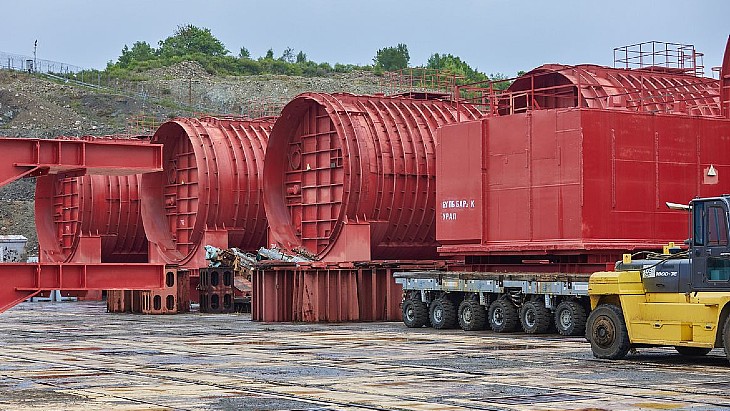Holtec delivers first 'dry' storage canisters to Chernobyl site
State Specialised Enterprise ChNPP said yesterday that the first 10 canisters for the dry interim fuel storage facility (ISF-2) had been delivered to the site of the Chernobyl nuclear power plant in Ukraine. ISF2 is in the final construction stage under a contract Ukraine signed with US-based Holtec International in 2007. To be completed this year, it will be used to store all the used fuel on the site for at least 100 years.
The 'double-walled' canisters are "at the heart of" the NUHOMS interim dry storage system to be used at ISF-2 for the long-term interim storage of used nuclear fuel from the Chernobyl plant's RMBK-1000 reactors. The purpose of this system is to store the used fuel for the entire design service life of ISF2 in an inert gas environment, SSE ChNPP said.
"The system consists of an enclosure vessel comprising two welded canisters that form two separate confinement areas to prevent the spread of radioactive materials, an internal basket and fuel tubes. It is designed for the horizontal placement of each canister inside the individual compartments of a concrete storage module," SSE ChNPP said.
The canisters are being produced at Holtec's manufacturing division in Pittsburgh, USA.
State Inspectorate for Nuclear Regulation of Ukraine (SNRC) approved the system's factory acceptance tests in July 2014, thus permitting serial manufacture of the canisters on condition that certain improvements to the design were made. SNRC approved the technical specifications of the canisters for ISF2 in July this year.
The first batch of 10 canisters was delivered to the Chernobyl site in two lots on 24 and 25 November, SSE ChNPP said, adding that the next batch of five canisters is to be delivered in January.
At the end of phase one of the ISF2 contract with Holtec, about 85 canisters will have been delivered to the site, which SSE ChNPP said will be sufficient for the facility for more than three years. The remaining canisters - making a total of 231 - will be delivered between 2017 and 2019, it said.
The transfer of undamaged used fuel to an on-site interim storage facility from units 1 to 3 of the Chernobyl plant was completed in 2013.
Used nuclear fuel from Chernobyl 1, 2 and 3 was progressively removed from plant cooling ponds and the reactor cores as part of an overall decommissioning program, separate from dealing with the destroyed unit 4. During the entire operation of the Chernobyl plant, more than 21,000 used fuel assemblies accumulated at the site.
On 28 September 2013 the final undamaged used fuel assembly from unit 1 was transferred to one of the five compartments in the cooling pool of the existing wet-type interim storage facility 1 (ISF-1). The transfer of all undamaged fuel from unit 3 to ISF-1 was completed in September 2010, while the last from unit 2 was moved in November 2012.
ISF-1 was commissioned in 1986, but its existing design does not allow for the storage of all the used fuel assemblies. ISF-2 will be used to store all the used fuel on the site for at least 100 years.
While some decommissioning infrastructure projects have been funded through bilateral aid, ISF2 and the Liquid Radioactive Waste Treatment Plant (LRTP) are being financed by the Nuclear Safety Account (NSA), which is managed by the European Bank for Reconstruction and Development (EBRD).
ISF2 will process, dry and cut more than 20,000 fuel assemblies from Chernobyl units 1-3, which will then be placed in metals casks for enclosing in concrete modules on site. Completion of the facility is scheduled for 2017. Once all fuel has been transferred to the ISF2 the current storage can be decommissioned. London-based EBRD has said that this will represent a major step forward in increasing nuclear safety at the site.
The LRTP retrieves highly active liquids from their current tanks, processes them into a solid state and moves them to containers for long-term storage. Construction of the plant has been completed and the start of operations is imminent.
As of 2014 the NSA had committed some €280 million, provided by 18 donors, to decommissioning and safety projects in Chernobyl. The EBRD uses part of its €325 million commitment to Chernobyl for these projects. In November 2014 the EBRD Board of Governors approved an additional contribution of €350 million for the completion of the New Safe Confinement. This giant structure will make the old Chernobyl shelter and remnants of the damaged reactor safe and environmentally secure. Completion of the project is scheduled for the end of 2017.
The Chernobyl plant officially entered the decommissioning phase in April this year, following approval by SNRC. The first phase of decommissioning is the so-called final shutdown and preservation stage, which is expected to take 10 years.
On 26 April 1986, the Chernobyl plant suffered the worst nuclear accident in history when a power runaway event wrecked reactor 4. The three remaining reactor units, however, were vital to Ukraine's electricity needs and continued to operate for some years. Unit 2 shut down in 1991, unit 1 in 1996 and unit 3 in 2000.
Holtec has also been contracted to build a central used fuel storage facility (CSFSF) in Ukraine after winning a tender for the project in 2005. Ukraine's parliament, the Verkhovna Rada, in 2012 adopted a law on the siting, design and construction of the facility to store used fuel from Ukraine's Russian-built VVER nuclear power reactors. In January this year Holtec and the country’s nuclear power plant operator Energoatom signed an amendment to the contract to build the CSFSF at the Chernobyl plant and the supply of used nuclear fuel dry cask storage systems.
The CSFSF will receive used nuclear fuel from nine of the country's 15 reactors - seven VVER-1000s and two VVER-440s - located at Rovno, South Ukraine and Khmelnitsky. The Zaporozhe nuclear power plant operates its own on-site used fuel storage facility that was commissioned in 2001.
Researched and written
by World Nuclear News
_17992.jpg)
_75800.jpg)








_88592.jpg)

